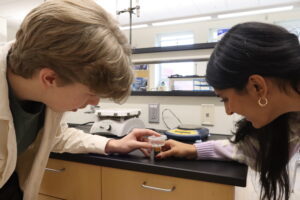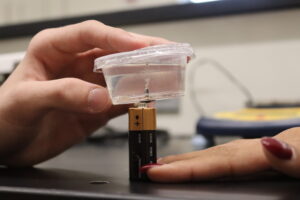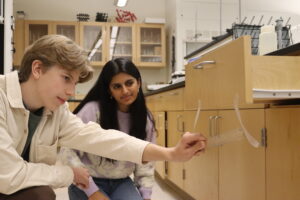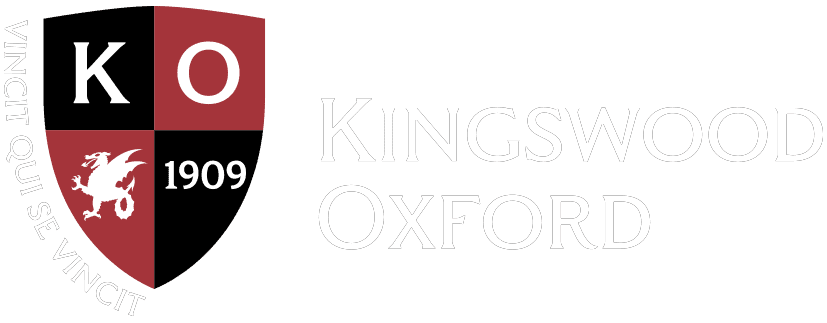October 30, 2024
Hands-on Discovery Powers Deep Understanding
by Tomas Kopecky
Upper School Chemistry Teacher
We learned in high school that water – H2O – contains two atoms of hydrogen and one atom of oxygen in a single molecule. But do we have any evidence that this is so? The students in my chemistry class figure it out for themselves.
Modeling Approach: the Spirit of Inquiry
Using “modeling,” a guided-inquiry approach to science, I encourage my students to immerse themselves in the hands-on process of collecting, recording, and analyzing data. Based on the empirical evidence they’ve gathered, they then formulate and design models that lead them to formulas or theories.
The students use large whiteboards to present and explain their evidence-based findings to their classmates who then evaluate and critique their claims. These presentations develop and sharpen their collaborative and communication skills. Because the students discover and construct scientific knowledge for themselves rather than having the teacher present it to them, they take ownership of the learning process and gain a deeper understanding of the scientific method. The students, not the teacher, are in charge, and this personal engagement and self-reliance gives them confidence in their own ability to work through future problems and find solutions. Perhaps most importantly, the modeling approach makes learning fun.
The H2O Challenge
Let’s return to the formula for water. How do we use the modeling approach to discover that water is H2O?
The Right Tool in the Right Hands
I provide each group of students with a miniature version of the Hoffman’s Apparatus. This device consists of a small plastic cup filled with water. The cup has two thumb tacks punched through its base with the sharp ends immersed in the water inside the cup, and the two round ends showing on the outside of the cup’s base. Students then connect a 9-volt battery to the base by touching the battery terminals with the round ends of the thumbtacks.

Electrifying Discovery
The electrical charge produced by the battery’s terminals causes bubbles of hydrogen and oxygen to rise through the water in the plastic cup. Students immediately notice that the bubbles of gas rising from one of the thumb tacks are produced much more rapidly than the bubbles rising from the other thumb tack. This indicates that water breaks into two different gases and one is far more abundant than the other gas.

A Burning Question Remains
But how can we verify that one electrode has produced hydrogen gas and the other oxygen gas in the 2:1 ratio? We perform the same experiment next on the larger scale with the actual Hoffman’s Apparatus. This apparatus is capable of measuring the amount of each gas produced and the students can see that the volume ratios of the two gases is approximately 2:1. When we insert a burning flint into the tube with the larger volume of gas, there’s a loud flash as the flammable hydrogen ignites. When we insert a glowing flint into the test tube with the smaller volume of gas, the flint glows brighter, but doesn’t burst into flame; that’s because oxygen supports combustion but doesn’t itself burn. Yup. We’ve proven it. Water is two-parts hydrogen and one part oxygen, thus H2O.
Modeling: From Adhesives to Atoms
Students engage in modeling to discover many other scientific phenomena. One of my favorites is the “sticky tape” lab where they explore the electrical charges possessed by everyday objects like scotch tape by sticking the tapes together and then quickly ripping them apart. They then explore how much they attract to other items like paper, aluminum foil or charged glass rod, thereby discovering the concept of electrical conductivity and polarity. 
When the students start the year, they first develop a simple model of matter that closely resembles the original Greek model of the atom. As they gradually discover evidence that both supports and contradicts this model, they refine it, applying the same interrogative process to each improved and more detailed model of the atom that has evolved through scientific history.
Experiential Learning
Evidence-based explorations like these engage students deeply in the scientific process. They learn that we never fully understand scientific concepts and principles until we experience and make sense of them first-hand.
Thinkers
Blog Main News
